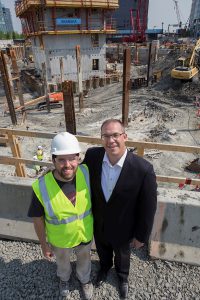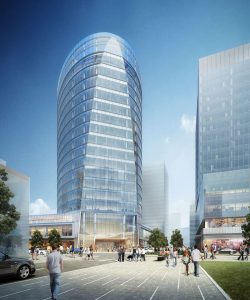Boston, MA Development and construction firm Skanska USA and the city of Boston presented the conclusion of an archeological investigation into the remains of a shipwrecked vessel discovered during excavation at the site of Skanska’s 121 Seaport development, a 17-story, 400,000 s/f class-A office building with two floors of retail currently under construction in the Seaport District.
 City of Boston archaeologist Joe Bagley and Skanska CEO & president Shawn Hurley standing in front of the shipwreck discovered at the 121 Seaport
City of Boston archaeologist Joe Bagley and Skanska CEO & president Shawn Hurley standing in front of the shipwreck discovered at the 121 SeaportDuring normal excavation operations at the site, a Skanska employee noticed an unexpected structure believed to be the outline of a boat hull. Recognizing its potential significance, the company halted construction and contacted the city of Boston archaeologist Joe Bagley, the Massachusetts Historic Commission and The Public Archaeology Laboratory to conduct an investigation of the ship’s potential historic significance.
A team of seven archaeologists including the Public Archaeology Laboratory, City Archaeology Program, nautical archaeologists, and archaeologists with the state of Massachusetts convened at the site to document the shipwreck. The team found:
• The 121 Seaport ship was wooden, about 50 feet long, and built sometime between the late 18th and mid-19th century. It had at least two masts.
• It held a large cargo of wooden barrels that contained lime, possibly from the Rockland area of Maine. The team found several dozen barrels of lime, suggesting the entire bottom of the ship was covered with lime barrels.
• The ship contained two knives, two forks, and a stack of burned plates in the rear of the ship.
• The ship sunk sometime between 1850 and 1880. The ship itself is likely older than the date it went down. It could have been made in the late 1700s or early 1800s.
• Most of the wood is charred, suggesting that the ship burned because when lime gets wet it reacts to produce heat, which can cause fires. The team was unable to determine if the 121 Seaport ship burned causing it to sink, if it was deliberately scuttled in the low-lying mudflats when the fire started, or if it ran aground and then burned.
• Due to age and severe deterioration of the wood due to the fire, removing the remains of the ship from the site in one piece is highly unlikely.
“We are so thankful to Skanska for voluntarily stopping construction to investigate this amazing find. We truly appreciate the opportunity to study the ship’s historical significance,” said Bagley. “We almost never get this kind of opportunity.”
“We’ve enjoyed working closely with the talented team of archaeologists in their search for more information about the ship. Skanska strives to be open and transparent, and we want to respect the communities where we develop and build. That means respecting their history,” said Shawn Hurley, president and CEO of Skanska USA commercial development. “We are highly invested in Boston and believe its history is part of what makes it so special. It is fascinating to unlock some of that history while building the city’s future.”
With the completion of the archaeological investigation and excavation, Skanska will resume construction activities. The company is committed to preserving as much of the deteriorated ship in its ongoing construction excavation process.
The company hired an independent consultant, The Public Archaeology Laboratory, which will continue to work with the city to conduct additional research on the ship and compile a report expected later this summer.
121 Seaport joins Skanska’s two additional Seaport developments - 101 Seaport, a 17-story, 440,000 s/f office tower with 20,000 s/f of ground floor retail which is home to PwC’s new headquarters, and Watermark Seaport, a 300,000 s/f residential building with ground floor retail that opened in early 2016 and is currently leasing. The three towers make up Boston’s most sustainable block and will connect Boston’s historic Fort Point neighborhood to its contemporary Seaport District with a specific design and vision which will bring convenient amenities to the neighborhood and exciting activity for the area’s residents, workers and visitors to enjoy when completed.
Skanska USA Commercial Development invests in and develops customer-focused, highly sustainable office and multi-family properties in Boston, Houston, Seattle and Washington, D.C. Since 2009, Skanska has invested approximately $1.5 billion in nearly a dozen projects in its select markets. Skanska self-finances the majority of its projects and serves as the construction manager. The group has developed projects for clients such as Brooks Sports, PwC and Tommy Bahama. Each Skanska USA Commercial Development project aims to achieve a minimum LEED Gold certification.









